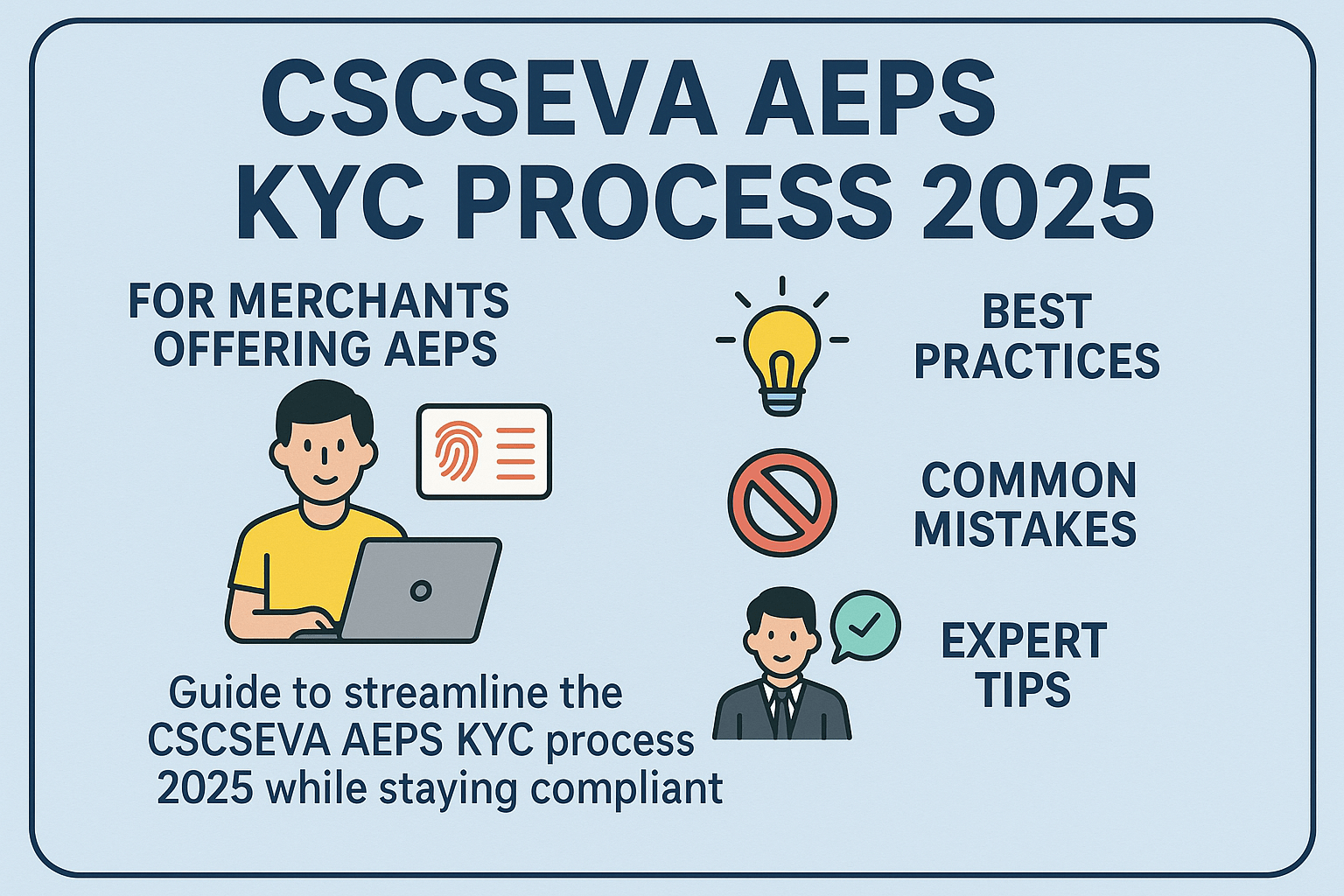The CSCSEVA AEPS KYC Process 2025 is a crucial step for merchants offering Aadhaar-enabled payment services (AEPS) in India. With digital transactions growing rapidly, ensuring a smooth and compliant KYC (Know Your Customer) process is essential. This guide breaks down everything merchants need to know—best practices, common mistakes, and expert tips—to streamline the CSCSEVA AEPS KYC Process 2025 while staying compliant with regulations.
What Is the CSCSEVA AEPS KYC Process?
The CSCSEVA AEPS KYC Process 2025 is a mandatory verification procedure for merchants enrolled under the Common Service Centres (CSC) scheme to provide AEPS services. It ensures that only legitimate users access financial services, reducing fraud and enhancing security.
Why Is KYC Important for AEPS Merchants?
-
Prevents fraud – Verifies customer identity before transactions.
-
Regulatory compliance – Mandated by RBI and UIDAI.
-
Builds trust – Customers feel secure using AEPS services.
Do’s of the CSCSEVA AEPS KYC Process 2025
1. Verify Aadhaar Details Accurately
-
Always cross-check the customer’s Aadhaar number and biometrics (fingerprint/iris scan).
-
Use UIDAI-approved devices for authentication to avoid errors.
2. Keep Customer Data Secure
-
Never store Aadhaar details in physical or unsecured digital formats.
-
Follow GDPR-like data protection measures even though India’s DPDP Act is in effect.
3. Educate Customers About KYC
-
Explain why KYC is necessary—many rural users may not understand the process.
-
Provide a step-by-step guide to ease apprehensions.
4. Regularly Update KYC Records
-
Re-verify customers if their Aadhaar details change.
-
Stay updated with RBI’s latest KYC guidelines to avoid penalties.
5. Use CSCSEVA’s Official Portal for KYC
-
Always submit KYC documents via the official CSC portal to prevent rejections.
-
Double-check entries before final submission.

Don’ts of the CSCSEVA AEPS KYC Process 2025
1. Don’t Skip Biometric Verification
-
AEPS relies on biometric authentication—never bypass it.
-
Fraudulent transactions can lead to legal consequences.
2. Avoid Manual Entry Errors
-
Typos in Aadhaar numbers or names can cause KYC failures.
-
Use barcode scanners (if available) for Aadhaar cards.
3. Never Share OTPs or Authentication Logs
-
Scammers may pose as officials asking for OTPs—never share them.
-
CSCSEVA will never ask for authentication details via call/SMS.
4. Don’t Process KYC Without Consent
-
Always take explicit customer consent before initiating KYC.
-
Unauthorized verification violates UIDAI guidelines.
5. Avoid Using Outdated Devices
-
Older biometric scanners may fail authentication.
-
Upgrade to UIDAI-certified devices for seamless processing.

Common Challenges in the CSCSEVA AEPS KYC Process
1. Poor Internet Connectivity
-
Rural areas often face network issues.
-
Solution: Use offline Aadhaar verification (e-KYC XML file) where possible.
2. Biometric Mismatches
-
Laborers or elderly customers may have worn-out fingerprints.
-
Solution: Use iris scanners as an alternative.
3. Delays in KYC Approval
-
Incomplete documents or errors can cause rejections.
-
Solution: Follow the CSCSEVA checklist before submission.
Future of AEPS KYC: What Merchants Should Expect in 2025
-
AI-based KYC: Faster verification using facial recognition.
-
Blockchain integration: Secure, tamper-proof KYC records.
-
Stricter compliance: Expect more audits from RBI and UIDAI.
Final Thoughts
The CSCSEVA AEPS KYC Process 2025 is a critical step for merchants to ensure secure and compliant transactions. By following the do’s and don’ts, staying updated with regulations, and using the right tools, merchants can avoid penalties and build customer trust.
Frequently Asked Questions (FAQs)
1. What happens if a merchant skips KYC for AEPS transactions?
Skipping KYC can lead to account suspension, fines, or legal action under PMLA (Prevention of Money Laundering Act).
2. Can a customer use AEPS without KYC?
No, biometric KYC is mandatory for all AEPS transactions.
3. How long does the CSCSEVA KYC approval take?
Typically 24-48 hours, but delays can occur if documents are incorrect.
4. Is Aadhaar mandatory for AEPS KYC?
Yes, Aadhaar is the primary document for AEPS KYC.
5. What should merchants do if biometric authentication fails?
Use iris scanning or ask the customer to update their Aadhaar biometrics at an enrollment center.
Disclaimer: This post is for educational purposes only. For any concerns regarding content ownership or removal, please visit our DMCA page for further guidance. Always verify official guidelines from CSCSEVA, UIDAI, or RBI before making compliance decisions.
